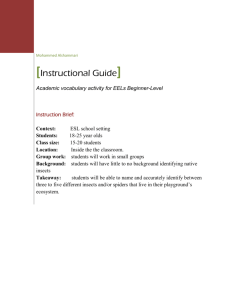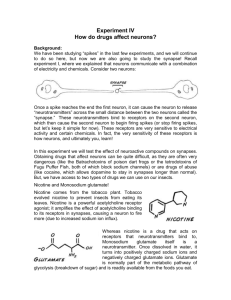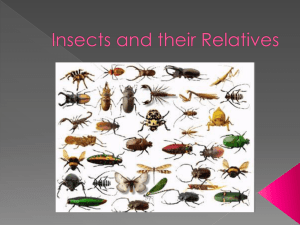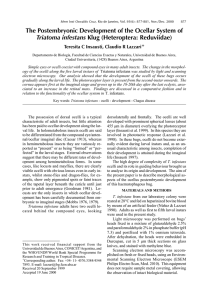- Patuakhali Science and Technology University
advertisement
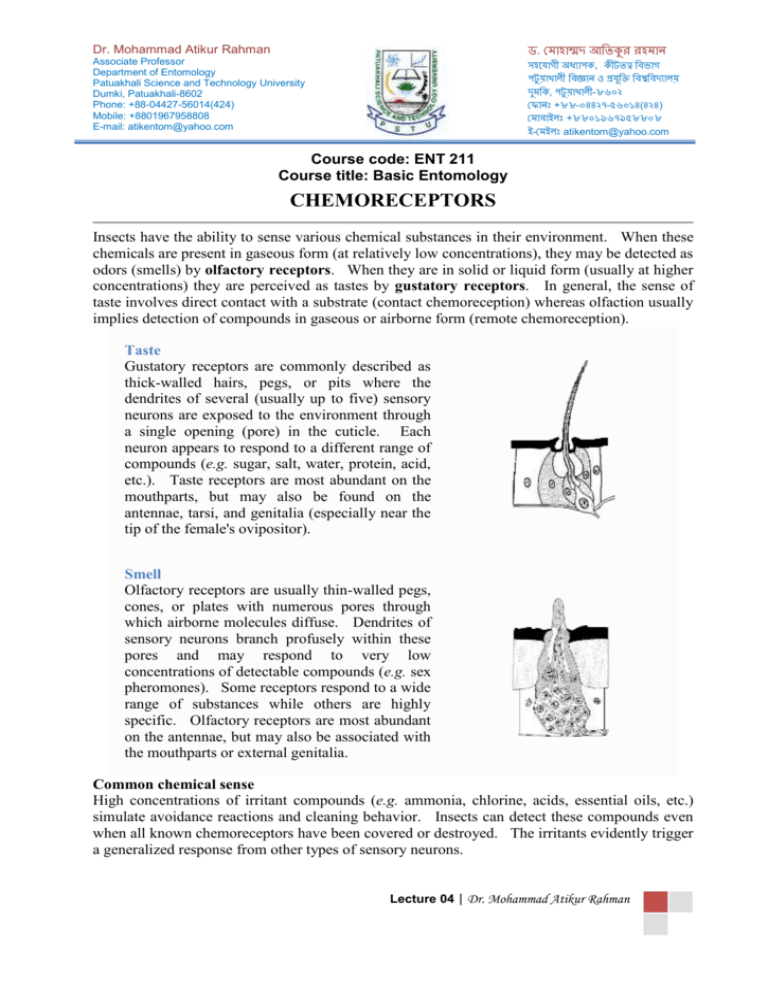
ড. ম োহোম্মদ আতিকুর রহ োন Dr. Mohammad Atikur Rahman Associate Professor Department of Entomology Patuakhali Science and Technology University Dumki, Patuakhali-8602 Phone: +88-04427-56014(424) Mobile: +8801967958808 E-mail: atikentom@yahoo.com সহয োগী অধ্যোপক, কীটিত্ত্ব তিভোগ পটু য়োখোলী তিজ্ঞোন ও প্র ুতি তিশ্বতিদযোলয় দু তক, পটু য়োখোলী-৮৬০২ ম োনঃ +৮৮-০৪৪২৭-৫৬০১৪(৪২৪) ম োিোইলঃ +৮৮০১৯৬৭৯৫৮৮০৮ ই-ম ইলঃ atikentom@yahoo.com Course code: ENT 211 Course title: Basic Entomology CHEMORECEPTORS Insects have the ability to sense various chemical substances in their environment. When these chemicals are present in gaseous form (at relatively low concentrations), they may be detected as odors (smells) by olfactory receptors. When they are in solid or liquid form (usually at higher concentrations) they are perceived as tastes by gustatory receptors. In general, the sense of taste involves direct contact with a substrate (contact chemoreception) whereas olfaction usually implies detection of compounds in gaseous or airborne form (remote chemoreception). Taste Gustatory receptors are commonly described as thick-walled hairs, pegs, or pits where the dendrites of several (usually up to five) sensory neurons are exposed to the environment through a single opening (pore) in the cuticle. Each neuron appears to respond to a different range of compounds (e.g. sugar, salt, water, protein, acid, etc.). Taste receptors are most abundant on the mouthparts, but may also be found on the antennae, tarsi, and genitalia (especially near the tip of the female's ovipositor). Smell Olfactory receptors are usually thin-walled pegs, cones, or plates with numerous pores through which airborne molecules diffuse. Dendrites of sensory neurons branch profusely within these pores and may respond to very low concentrations of detectable compounds (e.g. sex pheromones). Some receptors respond to a wide range of substances while others are highly specific. Olfactory receptors are most abundant on the antennae, but may also be associated with the mouthparts or external genitalia. Common chemical sense High concentrations of irritant compounds (e.g. ammonia, chlorine, acids, essential oils, etc.) simulate avoidance reactions and cleaning behavior. Insects can detect these compounds even when all known chemoreceptors have been covered or destroyed. The irritants evidently trigger a generalized response from other types of sensory neurons. Lecture 04 | Dr. Mohammad Atikur Rahman PHOTORECEPTORS Compound Eyes A pair of compound eyes are the principle visual organs of most insects; they are found in nearly all adults and in many immatures of ametabolous and hemimetabolous orders. As the name suggests, compound eyes are composed of many similar, closely-packed facets (called ommatidia) which are the structural and functional units of vision. The number of ommatidia varies considerably from species to species: some worker ants have fewer than six while some dragonflies may have more than 25,000. Externally,each ommatidium is marked by a convex thickening of transparent cuticle, the corneal lens. Beneath the lens, there is often a crystalline cone secreted by a pair of semper cells. Together, the lens and the crystalline cone form a dioptric apparatus that refracts incoming light down into a receptor region containing visual pigment. The light-sensitive part of an ommatidium is called the rhabdom. It is a rod-like structure, secreted by an array of 6-8 specialized neurons ( retinula cells), and centered on the optical axis just below the crystalline cone. The rhabdom contains an array of closely packed microtubules where lightsensitive pigments (e.g. rhodopsin, etc.) are stored. These pigments absorb certain wavelengths of incident light and generate nerve impulses through a photochemical process similar to that of vertebrates. Most diurnal insects have pigment cells surrounding each ommatidium. These cells limit a facet's field of view by absorbing light that enters through adjacent corneas. Each facet points toward a slightly different part of the visual field -- in composite, they render a mosaic-like impression of the environment. Nocturnal and crepuscular insects have pigment cells that do not completely isolate each facet. Their ommatidia are stimulated by light from larger fields of view. This produces a brighter but theoretically less distinct mosaic image. Lecture 04 | Dr. Mohammad Atikur Rahman Since insects cannot form a true (i.e. focused) image of the environment, their visual acuity is relatively poor compared to that of vertebrates. On the other hand, their ability to sense movement, by tracking objects from ommatidium to ommatidium, is superior to most other animals. Temporal resolution of flicker is as high as as 200 images/second in some bees and flies (in humans, still images blur into constant motion at about 30 images/second). They can detect polarization patterns in sunlight, and discriminate wavelengths in a range from ultraviolet to yellow (but not red). Ocelli -- Simple eyes Two types of "simple eyes" can be found in the class Insecta: dorsal ocelli and lateral ocelli (=stemmata). Although both types of ocelli are similar in structure, they are believed to have separate phylogenetic and embryological origins. Dorsal ocelli are commonly found in adults and in the immature stages (nymphs) of many hemimetabolous species. They are not independent visual organs and never occur in species that lack compound eyes. Whenever present, dorsal ocelli appear as two or three small, convex swellings on the dorsal or facial regions of the head. They differ from compound eyes in having only a single corneal lens covering an array of several dozen rhabdom-like sensory rods. These simple eyes do not form an image or perceive objects in the environment, but they are sensitive to a wide range of wavelengths, react to the polarization of light, and respond quickly to changes in light intensity. No exact function has been clearly established, but many physiologists believe they act as an "iris mechanism" -- adjusting the sensitivity of the compound eyes to different levels of light intensity. Dorsal Ocellus Lateral ocelli (=stemmata) are the sole visual organs of holometabolous Lateral Ocellus larvae and certain adults (e.g. Collembola, Thysanura, Siphonaptera, and Strepsiptera). Stemmata always occur laterally on the head, and vary in number from one to six on each side. Structurally, they are similar to dorsal ocelli but often have a crystalline cone under the cornea and fewer sensory rods. Larvae use these simple eyes to sense light intensity, detect outlines of nearby objects, and even track the movements of predators or prey. Covering several ocelli on each side of the head seems to impair form vision, so the brain must be able to construct a coarse mosaic of nearby objects from the visual fields of adjacent ocelli. Extra-ocular Photoreception Some (perhaps most) insects respond to changes in light intensity even when all known photoreceptive structures are rendered inoperative. This dermal light sense has been attributed to the response of individual neurons in the brain and/or ventral nerve cord. There is also convincing evidence that some insects can perceive infrared radiation (heat), although specific receptors for this ability have not been described. Stridulation Stridulation is the act of producing sound by rubbing together certain body parts. Insects and other arthropods stridulate by rubbing together two parts of the body. These are referred to generically as the stridulatory organs. Lecture 04 | Dr. Mohammad Atikur Rahman


